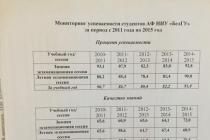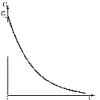Ascending and descending gaps provide very important information about the behavior of a function. Finding them is part of the function research and plotting process. In addition, the extremum points, at which there is a change from increasing to decreasing or from decreasing to increasing, special attention is paid when finding the largest and smallest values of the function on a certain interval.
In this article, we will give the necessary definitions, formulate a sufficient criterion for an increase and decrease of a function on an interval and sufficient conditions for the existence of an extremum, and apply this whole theory to solving examples and problems.
Page navigation.
Increase and decrease of a function on an interval.
Determination of an increasing function.
The function y = f (x) increases on the interval X if for any and ![]() inequality holds. In other words, the larger the value of the argument, the larger the value of the function.
inequality holds. In other words, the larger the value of the argument, the larger the value of the function.
Determination of a decreasing function.
The function y = f (x) decreases on the interval X if for any and ![]() the inequality holds
the inequality holds ![]() ... In other words, the larger the value of the argument, the smaller the value of the function.
... In other words, the larger the value of the argument, the smaller the value of the function.

NOTE: if the function is defined and continuous at the ends of the increasing or decreasing interval (a; b), that is, for x = a and x = b, then these points are included in the increasing or decreasing interval. This does not contradict the definitions of an increasing and decreasing function on the interval X.
For example, from the properties of basic elementary functions, we know that y = sinx is defined and continuous for all real values of the argument. Therefore, from the increase in the sine function on the interval, we can assert about the increase on the interval.
Extremum points, extremums of the function.
The point is called maximum point function y = f (x) if the inequality holds for all x from its neighborhood. The value of the function at the maximum point is called maximum function and denote.
The point is called minimum point function y = f (x) if the inequality holds for all x from its neighborhood. The value of the function at the minimum point is called minimum function and denote.
The neighborhood of a point is understood as the interval ![]() , where is a sufficiently small positive number.
, where is a sufficiently small positive number.
The minimum and maximum points are called extremum points, and the values of the function corresponding to the extremum points are called extrema of the function.

Do not confuse the extrema of a function with the largest and smallest value of a function.

In the first figure, the maximum value of the function on the segment is reached at the maximum point and is equal to the maximum of the function, and in the second figure, the maximum value of the function is reached at the point x = b, which is not a maximum point.
Sufficient conditions for the increase and decrease of the function.
On the basis of sufficient conditions (signs) for the increase and decrease of the function, the intervals of increase and decrease of the function are found.
Here are the formulations of signs of increasing and decreasing of a function on an interval:
- if the derivative of the function y = f (x) is positive for any x from the interval X, then the function increases by X;
- if the derivative of the function y = f (x) is negative for any x from the interval X, then the function decreases on X.
Thus, in order to determine the intervals of increasing and decreasing of the function, it is necessary:
Let's consider an example of finding the intervals of increasing and decreasing of a function to explain the algorithm.
Example.
Find the intervals of increasing and decreasing of the function.
Solution.
The first step is to find the domain of the function. In our example, the expression in the denominator should not vanish, therefore,.
We proceed to finding the derivative of the function: 
To determine the intervals of increase and decrease of the function by a sufficient criterion, we solve the inequalities and on the domain of definition. Let's use a generalization of the method of intervals. The only valid root of the numerator is x = 2, and the denominator vanishes at x = 0. These points divide the domain of definition into intervals in which the derivative of the function retains its sign. Let's mark these points on the number line. By pluses and minuses we conventionally denote the intervals on which the derivative is positive or negative. The arrows below schematically show the increase or decrease of the function on the corresponding interval. 
Thus,  and
and  .
.
At the point x = 2, the function is defined and continuous, so it should be added to both the increasing and decreasing intervals. At the point x = 0, the function is not defined; therefore, we do not include this point in the sought intervals.
We give a graph of the function to compare the results obtained with it.

Answer:
The function increases with ![]() , decreases on the interval (0; 2].
, decreases on the interval (0; 2].
Sufficient conditions for the extremum of a function.
To find the maxima and minima of a function, you can use any of the three signs of an extremum, of course, if the function satisfies their conditions. The most common and convenient is the first one.
The first sufficient condition for an extremum.
Let the function y = f (x) be differentiable in the -neighborhood of the point, and continuous at the point itself.
In other words:
Algorithm for finding extremum points by the first sign of the extremum of a function.
- Find the domain of the function.
- Find the derivative of the function on the domain of definition.
- Determine the zeros of the numerator, the zeros of the denominator of the derivative, and the points of the domain where the derivative does not exist (all of these points are called points of possible extremum passing through these points, the derivative can just change its sign).
- These points divide the domain of the function into intervals in which the derivative retains its sign. We determine the signs of the derivative on each of the intervals (for example, calculating the value of the derivative of the function at any point in a particular interval).
- We choose the points at which the function is continuous and, passing through which, the derivative changes sign - they are the extremum points.
Too many words, let's better consider several examples of finding the extremum points and extrema of a function using the first sufficient condition for the extremum of a function.
Example.
Find the extrema of the function.
Solution.
The domain of a function is the entire set of real numbers, except for x = 2.
Find the derivative: 
The zeros of the numerator are the points x = -1 and x = 5, the denominator vanishes at x = 2. We mark these points on the numerical axis 
Determine the signs of the derivative on each interval, for this we calculate the value of the derivative at any of the points of each interval, for example, at the points x = -2, x = 0, x = 3 and x = 6.
Therefore, on the interval the derivative is positive (in the figure, we put a plus sign above this interval). Likewise 
Therefore, we put a minus above the second interval, a minus above the third, and a plus above the fourth.
It remains to choose the points at which the function is continuous and its derivative changes sign. These are the extremum points.
At the point x = -1 the function is continuous and the derivative changes sign from plus to minus, therefore, according to the first sign of an extremum, x = -1 is a maximum point, it corresponds to the maximum of the function  .
.
At the point x = 5 the function is continuous and the derivative changes sign from minus to plus, therefore, x = -1 is a minimum point, it corresponds to the minimum of the function  .
.
Graphic illustration.

Answer:
PLEASE NOTE: the first sufficient criterion for an extremum does not require the function to be differentiable at the point itself.
Example.
Find the extremum points and extrema of the function ![]() .
.
Solution.
The domain of a function is the entire set of real numbers. The function itself can be written as: 
Let's find the derivative of the function: 
At the point x = 0, the derivative does not exist, since the values of the one-sided limits do not coincide when the argument tends to zero: 
At the same time, the original function is continuous at the point x = 0 (see the section on studying the function for continuity): 
Let's find the values of the argument at which the derivative vanishes: 
We mark all the points obtained on the number line and determine the sign of the derivative on each of the intervals. To do this, we calculate the values of the derivative at arbitrary points of each interval, for example, at x = -6, x = -4, x = -1, x = 1, x = 4, x = 6.
That is, 
Thus, according to the first sign of an extremum, the minimum points are ![]() , the maximum points are
, the maximum points are ![]() .
.
We calculate the corresponding minima of the function 
We calculate the corresponding maxima of the function 
Graphic illustration.

Answer:
 .
.
The second sign of the extremum of the function.
As you can see, this criterion for the extremum of a function requires the existence of a derivative at least up to the second order at a point.
With this service you can find the largest and smallest function value one variable f (x) with the design of the solution in Word. If the function f (x, y) is given, therefore, it is necessary to find the extremum of the function of two variables. You can also find the intervals of increasing and decreasing of the function.
Function entry rules:
A necessary condition for the extremum of a function of one variable
The equation f "0 (x *) = 0 is a necessary condition for the extremum of a function of one variable, i.e. at the point x * the first derivative of the function must vanish. It selects stationary points x c at which the function does not increase or decrease ...Sufficient condition for the extremum of a function of one variable
Let f 0 (x) be twice differentiable with respect to x belonging to the set D. If at point x * the following condition is met:F "0 (x *) = 0
f "" 0 (x *)> 0
Then the point x * is the point of the local (global) minimum of the function.
If at point x * the following condition is met:
F "0 (x *) = 0
f "" 0 (x *)< 0
Then the point x * is the local (global) maximum.
Example # 1. Find the largest and smallest values of the function: on the segment.
Solution. ![]()
One critical point x 1 = 2 (f '(x) = 0). This point belongs to the line segment. (The point x = 0 is not critical, since 0∉).
We calculate the values of the function at the ends of the segment and at the critical point.
f (1) = 9, f (2) = 5/2, f (3) = 3 8/81
Answer: f min = 5/2 at x = 2; f max = 9 at x = 1
Example # 2. Using the derivatives of higher orders, find the extremum of the function y = x-2sin (x).
Solution.
Find the derivative of the function: y ’= 1-2cos (x). Find the critical points: 1-cos (x) = 2, cos (x) = ½, x = ± π / 3 + 2πk, k∈Z. We find y ’’ = 2sin (x), calculate, so x = π / 3 + 2πk, k∈Z are the minimum points of the function; ![]() , so x = - π / 3 + 2πk, k∈Z are the maximum points of the function.
, so x = - π / 3 + 2πk, k∈Z are the maximum points of the function.
Example No. 3. Explore the extremum of the function in the vicinity of the point x = 0.
Solution. Here it is necessary to find the extrema of the function. If the extremum is x = 0, then find out its type (minimum or maximum). If among the found points there is no x = 0, then calculate the value of the function f (x = 0).
It should be noted that when the derivative on each side of a given point does not change its sign, the possible situations are not exhausted even for differentiable functions: it may happen that for an arbitrarily small neighborhood on one side of the point x 0 or on both sides the derivative changes sign. At these points, other methods have to be applied to study the functions for extremum.
Example No. 4. Divide the number 49 into two terms, the product of which will be the largest.
Solution. Let us denote x as the first term. Then (49-x) is the second term.
The product will be the maximum: x (49-x) → max
or
49x - x 2
Largest cylinder volume
Find the dimensions of a cylinder of the largest volume made from a workpiece in the form of a ball of radius R.Solution:

The volume of the cylinder is: V = πr 2 H
where H = 2h,
Let's substitute these values into the objective function.
V → max
Let's find the extremum of the function. Since the volume function V (h) depends on only one variable, we will find the derivative using the service
From this article, the reader will learn about what an extremum of functional value is, as well as about the features of its use in practice. Learning such a concept is essential to understanding the fundamentals of higher mathematics. This topic is fundamental for a deeper study of the course.
In contact with
What is an extremum?
In the school course, there are many definitions of the concept of "extremum". This article is intended to give the deepest and clearest understanding of the term for those uninformed in the matter. So, the term is understood to what extent the functional interval acquires the minimum or maximum value on a particular set.
The extremum is both the minimum value of the function and the maximum at the same time. Distinguish between a minimum point and a maximum point, that is, the extreme values of the argument on the chart. The main sciences in which this concept is used:
- statistics;
- machine control;
- econometrics.
Extremum points play an important role in determining the sequence of a given function. The coordinate system on the graph shows at its best the change in the extreme position depending on the change in functionality.
The extrema of the derivative of a function
There is also such a phenomenon as "derivative". It is necessary to determine the extremum point. It is important not to confuse the minimum or maximum points with the highest and lowest values. These are different concepts, although they may seem similar.
The value of the function is the main factor in determining how to find the maximum point. The derivative is not formed from values, but exclusively from its extreme position in one order or another.
The derivative itself is determined based on the data of the extremum points, and not the highest or lowest value. In Russian schools, the line between these two concepts is not clearly drawn, which affects the understanding of this topic in general.
Let's now look at such a thing as "acute extremum". Today, a sharp minimum value and an acute maximum value are distinguished. The definition is given in accordance with the Russian classification of critical points of a function. The concept of an extreme point is at the heart of finding critical points on a chart.

To define such a concept, one resorts to using Fermat's theorem. It is the most important in the study of extreme points and gives a clear idea of their existence in one form or another. To ensure extremeness, it is important to create certain conditions for decreasing or increasing on the graph.
For an accurate answer to the question "how to find the maximum point", you must follow the following provisions:
- Finding the exact area of definition on the chart.
- Search for the derivative of the function and the extremum point.
- Solve standard inequalities for the domain of the argument.
- To be able to prove in which functions the point on the graph is defined and continuous.

Attention! The search for the critical point of a function is possible only in the case of the existence of a derivative of at least second order, which is ensured by a high proportion of the presence of an extremum point.
A necessary condition for the extremum of a function
In order for an extremum to exist, it is important that there are both minimum and maximum points. If this rule is observed only partially, then the condition for the existence of an extremum is violated.

Each function in any position must be differentiated in order to reveal its new meanings. It is important to understand that the case of a point vanishing is not the basic principle of finding a differentiable point.
A sharp extremum, as well as a minimum of a function, is an extremely important aspect of solving a mathematical problem using extreme values. In order to better understand this component, it is important to refer to the tabular values for specifying the functionality.
| A complete study of the meaning | Plotting a value |
| 1. Determination of the points of increasing and decreasing values. 2. Finding points of break, extremum and intersection with the coordinate axes. 3. The process of determining changes in position on the chart. 4. Determination of the exponent and direction of convexity and convexity, taking into account the presence of asymptotes. 5. Creation of a summary table of the study in terms of determining its coordinates. 6. Finding the intervals of increasing and decreasing extreme and sharp points. 7. Determination of convexity and concavity of a curve. 8. Building a graph based on the study allows you to find a minimum or maximum. |
The main element, when it is necessary to work with extremes, is the accurate construction of its graph. School teachers do not often pay maximum attention to such an important aspect, which is a gross violation of the educational process. The plotting of the graph occurs only following the results of the study of functional data, the determination of sharp extremes, as well as points on the graph. Sharp extremes of the derivative of the function are plotted on the graph of exact values using the standard procedure for determining the asymptotes. The maximum and minimum points of the function are accompanied by more complex plotting. This is due to a deeper need to work out the problem of an acute extreme. It is also necessary to find the derivative of a complex and simple function, since this is one of the most important concepts of extremum problems. |
Functional extremum
In order to find the above value, you must adhere to the following rules:
- determine the necessary condition for an extreme attitude;
- take into account the sufficient condition of the extreme points on the graph;
- calculate the sharp extremum.
Also used are concepts such as weak lows and strong lows. This must be taken into account when determining an extremum and calculating it accurately. At the same time, the sharp functionality is the search and creation of all the necessary conditions for working with the function graph.
FUNCTIONS AND LIMITS IX
§ 205. Extreme values of the function
In this section, we will study some questions of the behavior of the function at =f (NS ) in the interval [ a, b ]. In this case, of course, we will assume that the function f (NS ) is defined at each point of this interval.
The largest of all the values that the function takes at =f(NS) in the interval [a, b ], is called its absolute maximum, and the smallest is called the absolute minimum in a given interval.
For example, for the function at =f (NS ), graphically presented in Figure 274, the absolute minimum in the interval is the value f (0) = 1, and the absolute maximum is the value f (6) =5.
Along with the absolute maximum and the absolute minimum in mathematics, one often speaks of local (i.e., local) maxima and minima.
Point x = c lying inside the interval[a, b ], is called the point of local maximum of the function at =f(NS) if for all values NS close enough to with,
f (NS ) < f (with ) . (1)
Function values at =f(NS) v points of its local maxima are called local maxima of this function.
For example, for the function at =f(NS) , graphically shown in Figure 274, the points of the local maximum are the points NS = 2 and NS = 6, and the local maxima themselves are the values
f (2) = 3 and f (6) = 5.
At points NS = 2 and NS = 6 function f(NS) takes on values that are larger than at neighboring points that are close enough to them:
f (2) >f (NS ); f (6) > f (NS ).
For function at =f(NS) , graphically presented in Figure 275, the point of the local maximum will be, for example, the point x = c ... For all NS close enough to with ,
f (NS ) = f (with ) ,
so condition (1) is satisfied.

Point NS = x 1 is also a local maximum point. For all values NS close enough to x 1 f (NS ) < f (x 1) if NS < x 1, and f (NS ) = f (x 1) if NS > x 1 . Therefore, in this case too f (NS ) < f (x 1). Here comes the point NS = x 2 will no longer be a local maximum point. To the left of it f (NS ) = f (x 2), but to the right of it f (NS ) > f (x 2) ,. Therefore, condition (1) is not met.
Point x = c lying inside the interval[a, b ], is called the point of local minimum of the function at =f(NS) if for all values NS close enough towith,
f (NS ) > f (with ) . (2)
The values of a function at the points of its local minima are called local minima of this function.
For example, for the function at =f(NS) , graphically presented in Figure 274, the point of the local minimum is the point NS = 3, and the local minimum itself is the value f (3) = 2.
For the function graphically presented in Figure 275, the point of the local minimum will be, for example, the point NS = x 2. For all values NS close enough to x 2 , f (NS ) = f (x 2) if NS < x 2, and f (NS ) > f (x 2) if NS > x 2. Therefore, the condition f (NS ) > f (x 2) is performed.
Point x = c , marked by us above as a point of a local maximum, is at the same time a point of a local minimum. After all, for all points NS close enough to her
f (NS ) = f (with ),
and therefore, formally, the inequality f (NS ) > f (with ) performed.
Minimum points and maximum points of a function f (NS ) are called m with extreme points this function. Function values f (NS ) at the extremum points are called the extreme values of this function.
Figure 274 shows the difference between absolute and local extremes. Function at =f(NS) shown in this figure has at the point NS = 2 local maximum, which is not the absolute maximum in the interval. Likewise the point NS = 3 this function has a local minimum, which is not an absolute minimum in the interval.
If the absolute maximum of the function at =f(NS) in the interval [ a, b ] is reached at the inner point of this interval, then this absolute maximum is obviously also a local maximum (see, for example, Fig. 274 at the point NS = 6). But it may happen that this absolute maximum is not reached within the interval [ a, b ], and at some extreme point (Fig. 276).

Then it is not a local maximum. This implies the following rule for finding the absolute maximum of the function at =f(NS) in the interval [ a, b ],
1. Find all local maxima of the function at =f(NS) in this interval.
2. To the obtained values we add the values of this function at the ends of this interval, that is, the values f (a ) and f (b ).
The largest of all these values will give us the absolute maximum of the function at =f(NS) in the interval [ a, b ]. The absolute minimum of the function at =f(NS) in the interval [ a, b ].
Example. Find all local extrema of a function at = x 2 - 2NS - 3. What are the largest and smallest values of this function in the interval?
We transform this function by selecting a full square:
at = x 2 - 2NS + 1 -4 = (NS - 1) 2 - 4.
Now it's easy to plot her. It will be a parabola directed upward with apex at point (1, -4) (Fig. 277).

The only point of the local extremum is the point NS = 1. At this point, the function has a local minimum equal to -4. To find the largest and smallest values of a given function in the interval, note that for x = 0 at = - 3, and at NS = 5 at = 12. Of the three values -4, -3 and 12, the smallest is -4, and the largest is 12. Thus, the smallest value (absolute minimum) of this function in the interval is -4; it is achieved at NS = 1. The largest value (absolute maximum) of this function in the interval is 12; it is achieved at NS = 5.
Exercises
1589. Which of the functions known to you on the whole number line:
a) have no local extrema at all;
b) have exactly one local extremum;
c) have an infinite set of local extrema?
Find the points of local extrema and the local extrema of these functions in exercises # 1590-1600. Find out what these extremes are (highs or lows):

Find the absolute extrema of these functions in the specified intervals (No. 1601-1603):
1601. at = - 2x 2 - 3x - 1 in the interval | NS | < 2.
1602. at = | x 2 + 5x + 6 | in the interval [- 5, 4].
1603. at = sin x - cos x in the interval [- π / 3 , π / 3 ]
1604. Find the absolute extrema of the function
at = (NS - 3) (NS - 5)
in intervals.














